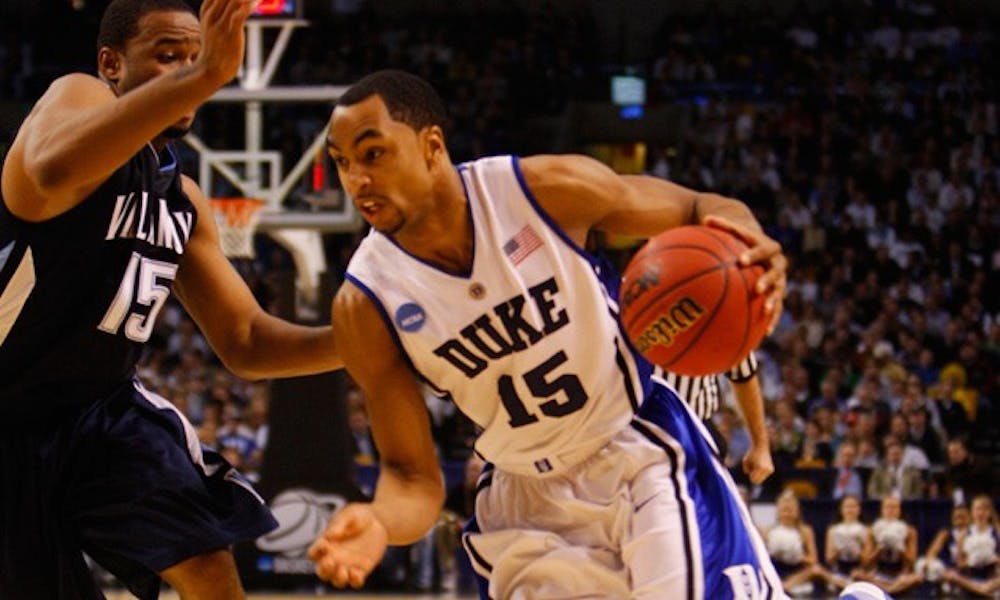Enough talk about Duke’s “Big Three.” It’s time to start talking about the Blue Devils’ new “Core Four.” The rise of center Brian Zoubek has been well-publicized over the past month—the seven-footer has averaged over nine rebounds per game since his 16-point, 17-rebound effort against Maryland Feb. 13. With Zoubek providing a dominant presence on the boards to complement Duke’s high-scoring perimeter attack, the Blue Devils are in good shape to cut down the nets once more this season—this time in Indianapolis April 5.
Featuring head coach Mike Krzyzewski’s most balanced offensive attack since his most recent Final Four team in 2004, this 2010 Duke squad is poised to make a deep NCAA Tournament run. Point guard Jon Scheyer has displayed uncanny will and determination all year, and he has emerged as a true 3-point-shooting, driving, pass-distributing triple threat. ACC Tournament MVP Kyle Singler is playing lights-out basketball at the most important time of the year, dispelling the popular notion that Krzyzewski’s heavy reliance on his top players leads to them burning out in March. And guard Nolan Smith has been remarkably consistent all season, both offensively and defensively.
Not since 2004—when senior point guard Chris Duhon, sophomore shooting guard J.J. Redick and one-and-done freshman swingman Luol Deng led the Blue Devils—has Duke featured such a dangerous offensive trio.
Critics will point to Duke’s thin backcourt. In reality, the backcourt issue hasn’t been a problem. Scheyer and Smith are each averaging 35-plus minutes per game, yet show no signs whatsoever of wearing down. Andre Dawkins has displayed some flashes of slashing ability, indicating he might be more than a Taylor King-type spot-up shooter. Duke’s backcourt may be thin, but it is actually one of the nation’s best.
Perhaps most importantly, Duke’s offense is balanced enough to withstand a disastrous effort from one of its top players come tournament time. Specifically, the kind of effort that doomed the Blue Devils last year—when Gerald Henderson went 1-of-14 from the field and Villanova crushed Duke by 23 points in the Sweet 16. With Zoubek’s rebounding providing the Blue Devils with many second-chance opportunities, and with the bevy of scorers at Krzyzewski’s disposal, this year’s Duke team seems fully capable of compensating for a poor performance by one of its best players.
Lastly, Blue Devil fans should thank their lucky stars that the NCAA Tournament selection committee gave Duke such a clear path to the Final Four. A potentially scary second-round matchup against Rick Pitino’s talented Louisville team notwithstanding, Duke could draw a plummeting Purdue team lacking its most talented player, as well as a No. 2-seeded Villanova squad that has dropped five of its last seven games heading into the NCAA Tournament.
Alternatively, the Blue Devils could face No. 5-seeded Texas A&M in the Sweet 16 and No. 3-seeded Baylor in the Elite 8, which would essentially amount to two true road games since both would be played in Houston, Texas.
However, Duke matches up well against the Aggies’ guard-based lineup, and Blue Devil defensive stalwart Lance Thomas promises to be an imposing matchup problem for Bears center Ekpe Udoh.
Any path to the Final Four is going to be riddled with tough games and many uncertainties, but Duke’s road is remarkably easier than that of Kansas—which the selection committee nonetheless dubbed the best of the No. 1 seeds.
With a manageable road to Indianapolis and an emerging rebounding force in Zoubek to accompany the Big Three’s tremendous offensive production, Duke stands a good chance of bringing home the storied program’s fourth national championship and sending this year’s senior class out on top.
Get The Chronicle straight to your inbox
Signup for our weekly newsletter. Cancel at any time.

